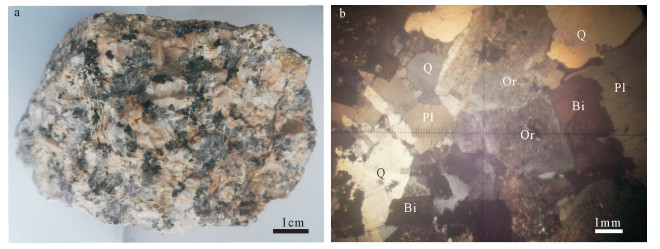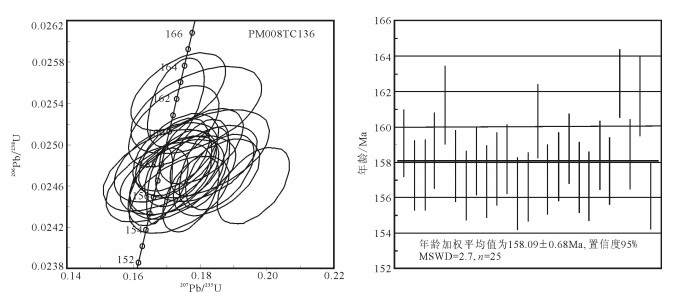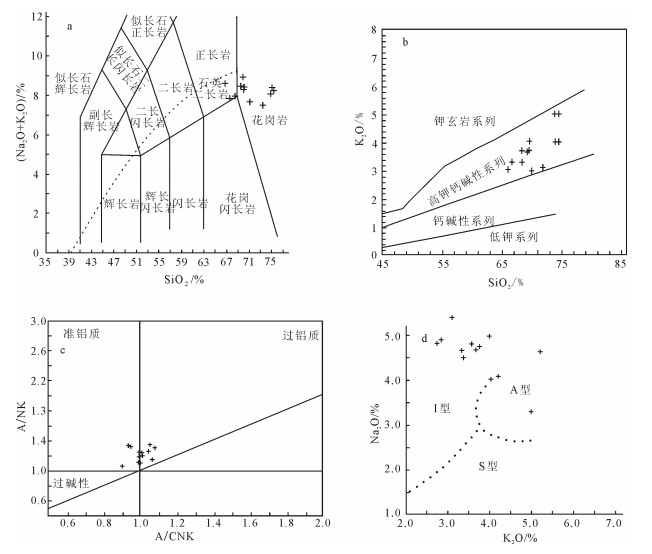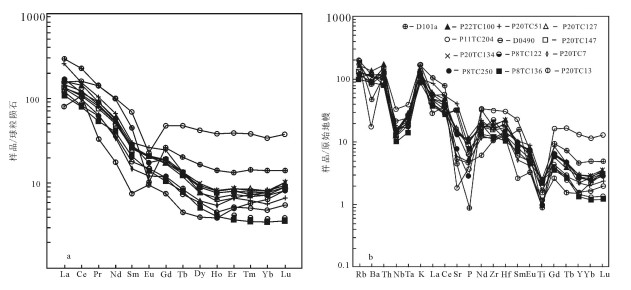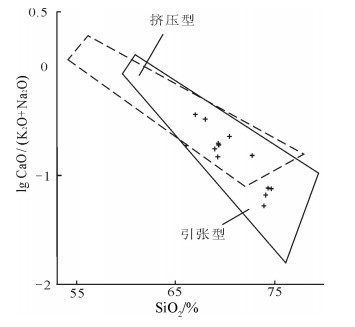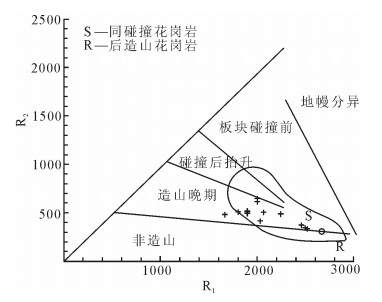LA-ICP-MS zircon U-Pb dating and geochemical characteristics of the Late Jurassic monzonitic granite from Yilehuli Mountain in northern Da Hinggan Mountains and their geological implications
-
摘要:
对大兴安岭北段伊勒呼里山地区二长花岗岩进行了LA-ICP-MS锆石U-Pb年龄和岩石地球化学研究,确定其形成时代、岩石成因,揭露区域大地构造环境。测年数据显示,二长花岗岩于158.1±0.7Ma前形成,为晚侏罗世早期岩浆演化事件的产物。地球化学结果显示,二长花岗岩具有高Si、富Na、K、Al,低Fe、Mg的特点,A/CNK值为0.83~1.09,属高钾钙碱性花岗岩;富集大离子亲石元素K、Rb,贫高场强元素Hf、Th;稀土元素总量较高,稀土元素配分曲线右倾,具弱的负Eu异常,为I型花岗岩。岩浆起源于下地壳玄武质成分的岩石部分熔融,为同碰撞期陆壳加厚过程的产物。研究区晚侏罗世早期二长花岗岩的形成与蒙古-鄂霍茨克缝合带闭合过程中的陆-陆碰撞环境有关,其形成时代限定了大兴安岭北段伊勒呼里山地区蒙古-鄂霍茨克洋的闭合时间应为晚侏罗世早期。
Abstract:LA-ICP-MS zircon U-Pb geochronologic study and whole-rock geochemical analysis were undertaken for the monzonitic granite in Yilehuli Mountain area in northern Da Hinggan Mountains, with the aim of constraining its formation time, petrogenesis and the regional tectonic setting. Dating data show that monzonitic granite formed at 158.1 ±0.7 Ma before the Late Jurassicearly magmatic evolution event. The geochemical studies show that the granite in the area has the characteristics of high Si, Na, K and Al and low Fe and Mg, with A/CNK being 0.83~1.09, thus belonging to high potassium calc alkaline granite; it is enriched in the large ion lithophile elements K, Rb, and depleted in high field strength elements Hf, Th; the total REE is higher, and the rare earth distribution curve is right-inclined, with weak negative Eu anomalies. According to these characteristics, the monzonitic granite should belong to type I granite. The magma originated from the rock melting of the of the basaltic components of the lower crust, being the product of the thickening process with the crust during the collision. The formation of the early Late Jurassic monzonitic granites in the study area were related to the continental-continental collision environment in the closure process of the Mongolian-Okhotsk suture zone, and the closing time of the Mongolia Okhotsk Ocean in North Da Hinggan Mountain-Yilehuli mountain area is also confined to early Late Jurassic.
-
Keywords:
- early Late Jurassic /
- monzonitic granite /
- geochemistry /
- Mongol-Okhotsk Ocean /
- Yilehuli Mountain
-
大兴安岭地区位于兴蒙造山带东段,自东向西散布有松嫩地块、兴安地块和额尔古纳地块(图 1),在晚古生代期间发生碰撞拼合[1-11]。在中生代又有环太平洋构造体系和蒙古-鄂霍茨克构造体系的影响[12-15]。近年来,对大兴安岭地区花岗质岩的岩石成因较多地强调古亚洲洋构造体系和环太平洋构造体系的影响[16-19],疏忽了蒙古-鄂霍茨克构造体系的影响。研究表明,中生代蒙古-鄂霍茨克洋显示自西向东剪刀式闭合的特征[20-21]。大兴安岭北段中生代花岗岩的形成,是否与蒙古-鄂霍茨克构造体系有关?这一疑问还没有答案。鉴于此,笔者对伊勒呼里山地区的二长花岗岩进行了年代学与地球化学研究,探讨其形成时代、岩石成因及形成的构造环境,为更深入地探讨大兴安岭北段构造格架及其演变提供证据。
1. 区域地质背景及主要岩石特征
研究区位于大兴安岭北部塔源西南(图 1),临近兴安地块与额尔古纳地块的缝合带。区内主要发育晚侏罗世和早白垩世岩浆活动,以中侏罗世晚期中酸性岩体分布最广泛;研究区内地层主要为上侏罗统塔木兰沟组、满克头鄂博组、玛尼吐组,下白垩统白音高老组。中侏罗世花岗岩广泛出露,主要岩石类型为黄灰色-灰色粗中粒二长花岗岩。岩体侵入下寒武统—新元古界倭勒根岩群吉祥沟岩组,被晚侏罗世火山岩角度不整合喷发掩盖。代表性样品岩石特征分述如下。
粗中粒二长花岗岩:粗中粒花岗结构,块状构造(图 2-a)。主要矿物钾长石(30%~35%)呈半自形-他形粒状,粒度为2~8mm,轻-中度高岭土化;斜长石(35%~45%)呈半自形板状,粒度大小为2~ 6mm,聚片双晶较细;石英(20%~25%)呈不规则粒状,粒度2~8mm不等;黑云母(2%~5%)呈片状,一组完全解理,平行消光,沿解理具绿泥石化;角闪石(0~2%)呈半自形-他形,一般长2~3mm,宽1mm左右,弱绿泥石化;另外,含微量锆石和磷灰石及少量磁铁矿(图 2-b)。
2. 锆石U-Pb年代学分析
为准确地确定岩石年代,在岩石特征鉴定的基础上,对研究区内广泛出露的二长花岗岩样品进行锆石LA-ICP-MS年龄测定。锆石测年由天津地质矿产研究所完成。测年仪器为ThermoFisHer公司制造的Neptune型LA-MIC-ICPMS和Cetac公司制造的GeolasPro193准分子型激光系统联机,用193nm激光器对锆石进行剥蚀的深度为20~ 40μm,激光剥蚀束斑直径为35μm。应用TEMORA和GJ-1作为外部锆石年龄标准进行分馏校正,元素含量采用玻璃标样SRM610作为外标,具体实验步骤和数据处理方法见参考文献[22-24]。年龄数据处理采用Ludwig开发的Isoplot程序[25]。分析结果见表 1。
表 1 晚侏罗世粗中粒二长花岗岩LA-ICP-MS锆石U-Th-Pb同位素测试结果(PM008TC136)Table 1. LA-ICP-MS zircon U-Th-Pb isotope test results for the Late Jurassic coarse-grained monzonitic granite (PM008TC136)分析序号 含量/10-6 同位素比值 年龄/Ma Pb U 206Pb/238U 1σ 误差/% 207Pb/235U 1σ 误差/% 207Pb/206Pb 1σ 误差/% 208Pb/232Th 1σ 误差/% 232Th/238U 1σ 误差/% 206Pb/238U 1σ 207Pb/235U 1σ 207Pb/206Pb 1σ 1 9 305 0.0250 0.0002 0.60 0.1802 0.0052 2.86 0.0523 0.0015 2.86 0.0107 0.0003 3.87 0.6025 0.0082 1.36 159 1 168 5 299 9 2 6 231 0.0247 0.0002 0.64 0.1722 0.0055 3.17 0.0506 0.0016 3.15 0.0101 0.0001 3.90 0.4525 0.0027 0.59 157 1 161 5 221 7 3 5 197 0.0247 0.0002 0.64 0.1734 0.0071 4.08 0.0509 0.0021 4.05 0.0100 0.0001 3.89 0.5423 0.0047 0.87 157 1 162 7 237 10 4 5 174 0.0249 0.0002 0.70 0.1807 0.0082 4.54 0.0526 0.0024 4.64 0.0108 0.0001 3.95 0.4835 0.0024 0.49 159 1 169 8 311 14 5 5 183 0.0253 0.0002 0.69 0.1789 0.0080 4.49 0.0512 0.0024 4.62 0.0104 0.0002 3.91 0.5120 0.0030 0.58 161 1 167 7 250 12 6 11 398 0.0248 0.0002 0.64 0.1813 0.0031 1.73 0.0531 0.0010 1.79 0.0109 0.0001 3.79 0.4836 0.0024 0.50 158 1 169 3 332 6 7 8 268 0.0246 0.0002 0.62 0.1959 0.0045 2.27 0.0577 0.0013 2.29 0.0114 0.0003 3.79 0.6412 0.0054 0.84 157 1 182 4 520 12 8 7 244 0.0248 0.0001 0.60 0.1818 0.0062 3.43 0.0531 0.0018 3.48 0.0121 0.0002 3.89 0.5067 0.0045 0.88 158 1 170 6 334 12 9 5 182 0.0246 0.0002 0.64 0.1676 0.0064 3.84 0.0493 0.0019 3.89 0.0120 0.0002 3.97 0.4130 0.0037 0.91 157 1 157 6 164 6 10 4 143 0.0248 0.0002 0.66 0.1680 0.0070 4.16 0.0492 0.0020 4.14 0.0125 0.0003 4.13 0.3555 0.0029 0.81 158 1 158 7 159 7 11 4 173 0.0248 0.0002 0.64 0.1698 0.0064 3.74 0.0496 0.0019 3.76 0.0125 0.0003 4.15 0.3130 0.0030 0.96 158 1 159 6 176 7 12 6 217 0.0245 0.0002 0.63 0.1738 0.0061 3.50 0.0514 0.0018 3.46 0.0117 0.0001 3.89 0.5304 0.0036 0.69 156 1 163 6 259 9 13 9 316 0.0246 0.0002 0.62 0.1674 0.0037 2.22 0.0494 0.0011 2.26 0.0105 0.0002 3.80 0.5200 0.0026 0.51 157 1 157 3 166 4 14 5 188 0.0252 0.0002 0.64 0.1721 0.0055 3.20 0.0496 0.0016 3.24 0.0111 0.0001 3.86 0.5063 0.0027 0.54 160 1 161 5 175 6 15 5 195 0.0247 0.0002 0.64 0.1731 0.0058 3.34 0.0509 0.0017 3.36 0.0104 0.0004 3.85 0.4986 0.0039 0.78 157 1 162 5 236 8 16 8 281 0.0248 0.0001 0.60 0.1735 0.0041 2.39 0.0508 0.0012 2.41 0.0106 0.0001 3.80 0.5892 0.0057 0.98 158 1 162 4 231 6 17 6 192 0.0249 0.0002 0.61 0.1727 0.0052 3.02 0.0502 0.0015 3.02 0.0104 0.0003 3.84 0.6996 0.0042 0.61 159 1 162 5 206 6 18 5 195 0.0247 0.0002 0.62 0.1849 0.0053 2.85 0.0543 0.0015 2.84 0.0102 0.0003 3.86 0.5170 0.0029 0.56 157 1 172 5 385 11 19 24 705 0.0246 0.0002 0.61 0.1678 0.0016 0.97 0.0495 0.0005 1.04 0.0099 0.0003 3.76 1.3388 0.0111 0.83 157 1 158 2 170 2 20 11 395 0.0249 0.0002 0.61 0.1797 0.0036 2.00 0.0524 0.0010 2.00 0.0098 0.0004 3.78 0.7296 0.0036 0.50 158 1 168 3 302 6 21 6 242 0.0247 0.0001 0.61 0.1858 0.0042 2.26 0.0545 0.0012 2.26 0.0104 0.0004 3.86 0.4001 0.0030 0.74 158 1 173 4 391 9 22 10 368 0.0255 0.0002 0.60 0.1735 0.0058 3.34 0.0493 0.0016 3.32 0.0108 0.0004 3.89 0.5218 0.0029 0.55 162 1 162 5 163 5 23 7 250 0.0249 0.0002 0.62 0.1721 0.0043 2.50 0.0502 0.0012 2.44 0.0107 0.0003 3.83 0.4810 0.0025 0.52 158 1 161 4 202 5 24 12 492 0.0254 0.0002 0.69 0.1727 0.0035 2.03 0.0493 0.0010 2.01 0.0133 0.0004 4.16 0.1184 0.0012 1.02 162 1 162 3 162 3 25 8 316 0.0245 0.0001 0.61 0.1773 0.0035 1.97 0.0524 0.0010 1.97 0.0123 0.0004 3.80 0.4234 0.0026 0.62 156 1 166 3 305 6 注:测试单位为天津地质矿产研究所测试中心 二长花岗岩样品(PM008TC136)采自1119高地。阴极发光图像显示,锆石颗粒均为自形异晶,且具有较明显的振荡环带(图 3)。样品的Th、U含量较高,Th/U值在0.31~1.33之间,多数大于0.4,具较典型的岩浆成因锆石特征。测得25个锆石的206Pb/238U年龄介于154±1~164±1Ma之间,其年龄加权平均值为158.09±0.68Ma(MSWD=2.7)(图 4)。可代表二长花岗岩的结晶年龄,表明其形成时代属晚侏罗世早期。
3. 岩石地球化学特征
二长花岗岩样品的主量元素测定由黑龙江省地质调查研究总院实验室完成,微量和稀土元素测定由沈阳地调中心实验测试中心完成。其中,主量元素采用X射线荧光光谱仪测定,相对标准偏差为2%~5%;微量及稀土元素均采用电感耦合等离子体质谱仪测定,相对标准偏差小于10%。
3.1 主量元素
由表 2可知,伊勒呼里山地区二长花岗岩的SiO2含量介于66.04%~74.38%之间,岩石酸性程度较高,K2O为2.75%~5.19%,CaO为0.51%~2.62%,Al2O3含量中等(11.71% ~16.5%),K2O/Na2O值为0.55~ 1.49,Na2O+K2O=7.52%~9.87%,Na2O>K2O;铝饱和指数A/CNK为0.83~1.09(<1.1)。MgO含量为0.2%~1.24%,TiO2含量为0.19%~0.53%。CIPW标准矿物出现刚玉(c)和磁铁矿(mt)。在侵入岩TAS图解(图 5-a)上,二长花岗岩样品点多数落入花岗岩区域,部分落在石英二长岩,与岩相学观察特征基本一致。在SiO2-K2O图解(图 5-b)上,二长花岗岩样品点落入高钾钙碱性区。在铝饱和指数图解(图 5-c)上,样品点落入准铝-弱过铝质花岗岩区。在K2O-Na2O图解(图 5-d)上落入I型花岗岩区。
表 2 晚侏罗世二长花岗岩主量、微量和稀土元素组成及特征参数Table 2. Analytical data and parameters of major, trace and rare earth elements for the Late Jurassic monzonitic granite样品号 D0011a D0490 P11TC204 P20TC127 P20TC13 P20TC134 P20TC147 P20TC51 P20TC7 P22TC100 P8TC122 P8TC136 P8TC250 SiO2 74.02 70.42 74.38 68.98 74.14 69.34 69.28 66.04 74.70 69.22 66.96 67.92 72.78 TiO2 0.19 0.36 0.34 0.46 0.25 0.49 0.47 0.52 0.20 0.45 0.53 0.52 0.22 Al2O3 12.43 14.96 12.14 15.06 12.79 14.81 14.78 16.50 12.50 14.87 14.96 15.01 13.04 Fe2O3 1.60 1.00 1.55 1.76 1.04 1.91 1.85 2.34 1.31 2.17 1.92 2.31 0.61 FeO 0.60 2.41 1.70 1.65 1.44 1.88 1.54 1.63 1.34 1.86 1.78 1.64 2.26 MnO 0.03 0.04 0.03 0.04 0.02 0.04 0.04 0.04 0.04 0.08 0.05 0.04 0.15 MgO 0.43 0.97 0.20 0.90 0.41 0.88 0.84 0.91 0.49 0.64 1.24 1.07 0.40 CaO 0.51 1.76 0.66 1.49 0.54 1.68 1.61 1.62 0.63 1.35 2.83 2.62 1.17 Na2O 4.68 4.88 3.37 4.73 4.07 4.84 4.69 5.56 4.14 4.98 4.5 4.68 4.77 K2O 5.19 2.83 5.05 3.75 4.04 3.62 3.67 3.08 4.16 4.02 3.38 3.29 2.75 P2O5 0.02 0.13 0.08 0.21 0.10 0.21 0.19 0.24 0.10 0.12 0.24 0.17 0.06 烧失量 0.56 0.36 0.18 0.58 0.50 0.24 0.44 0.97 0.26 0.26 1.18 0.44 1.20 总计 100.26 100.12 99.68 99.61 99.34 99.94 99.40 99.45 99.87 100.02 99.57 99.71 99.41 σ 3.14 2.17 2.26 2.77 2.11 2.72 2.66 3.24 2.17 3.09 2.59 2.55 1.9 SI 3.44 8.02 1.68 7.04 3.73 6.70 6.67 6.73 4.28 4.68 9.67 8.24 3.71 Alk 9.87 7.71 8.42 8.48 8.11 8.46 8.36 8.64 8.30 9.00 7.88 7.97 7.52 A/CNK 0.87 1.05 0.94 0.92 1.01 0.99 1.00 1.06 1.07 1.04 0.99 1.01 0.99 K/Na 1.11 0.58 0.70 0.75 0.58 1.50 1.00 0.99 0.55 0.79 0.75 0.78 0.81 A/MF 3.13 2.09 1.88 1.84 2.61 2.48 2.60 2.90 2.17 2.19 2.02 2.21 2.12 AR 7.43 2.71 4.84 3.10 4.11 3.11 3.08 2.82 4.44 3.49 2.59 2.65 3.25 La 70.8 27.2 37.2 32.3 19.1 34.1 33.5 60.3 32.2 41.3 28.2 25.7 40.0 Ce 138 49.2 99.0 69.6 65.2 75.0 65.5 96.2 58.1 83.2 53.2 46.8 70.3 Pr 13.9 5.46 13.3 7.87 3.14 7.96 7.72 9.91 5.87 8.38 5.88 5.15 8.52 Nd 45.4 17.1 46.4 24.9 8.25 25.0 24.2 31.0 15.8 25.4 21.1 18.6 27.0 Sm 6.99 2.68 10.50 4.17 1.14 4.06 3.96 4.66 2.27 3.83 3.54 3.16 4.34 Eu 0.60 0.82 1.30 1.23 0.55 1.18 1.19 1.51 0.70 1.25 0.87 0.80 1.00 Gd 5.55 2.33 9.89 3.89 1.53 3.84 3.66 5.05 2.45 3.59 2.54 2.19 4.04 Tb 0.77 0.28 1.80 0.51 0.17 0.50 0.48 0.49 0.31 0.44 0.32 0.29 0.51 Dy 4.14 1.39 10.79 2.46 1.01 2.45 2.27 1.99 1.55 2.05 1.46 1.31 2.33 Ho 0.81 0.26 2.15 0.46 0.22 0.46 0.43 0.35 0.31 0.37 0.26 0.23 0.43 Er 2.26 0.87 6.44 1.44 0.85 1.45 1.33 1.13 1.11 1.18 0.70 0.61 1.32 Tm 0.37 0.13 0.97 0.22 0.15 0.21 0.20 0.16 0.19 0.18 0.10 0.09 0.19 Yb 2.38 0.81 5.66 1.36 1.09 1.40 1.29 0.96 1.33 1.19 0.65 0.59 1.20 Lu 0.36 0.14 0.98 0.24 0.21 0.26 0.23 0.17 0.26 0.23 0.10 0.09 0.21 Y 20.4 7.18 59.3 13.4 6.93 13.3 12.4 10.0 10.4 12.6 6.70 6.02 12.1 ∑REE 312.73 115.85 305.68 164.05 109.54 171.17 158.36 223.88 132.85 185.19 125.62 111.63 173.49 LREE/HREE 16.57 16.50 5.37 13.24 18.62 13.94 13.76 19.77 15.30 17.70 18.40 18.55 14.78 (La/Yb)N 29.75 33.58 6.57 23.75 17.52 24.36 25.97 62.81 24.21 34.71 43.38 43.56 33.33 (La/Sm)N 10.13 10.15 3.54 7.75 16.75 8.40 8.46 12.94 14.19 10.78 7.97 8.13 9.22 δCe 1.00 0.92 1.07 1.02 1.85 1.06 0.95 0.86 0.95 1.02 0.95 0.93 0.88 δEu 0.29 0.98 0.38 0.92 1.27 0.90 0.94 0.95 0.90 1.02 0.85 0.88 0.72 Sr 92.4 684 36.7 342 113 322 315 869 125 295 272 695 165 Rb 124 77.5 116 79.1 107 82.3 85.5 67.9 116 106 132 65.8 72.5 Ba 330 546 122 844 599 758 812 850 590 922 824 625 637 Th 9.13 10.3 12.7 6.92 13.3 9.02 7.88 9.62 13.7 14.0 10.3 6.86 10.9 Nb 15.1 8.25 22.9 8.73 10.5 10.0 8.64 9.33 10.9 10.1 11.8 6.96 9.95 Zr 193 125 354 189 117 201 176 172 127 216 247 142 123 Cr 44.8 11.4 6.09 7.61 4.07 6.71 5.23 7.31 5.83 4.30 52.6 25.1 6.94 Ni 5.27 8.46 7.04 6.41 3.30 5.35 4.86 4.68 4.73 3.96 7.49 5.71 5.31 Ta 0.98 0.74 1.61 1.12 0.82 1.07 0.86 1.03 0.86 1.07 0.70 0.58 0.82 Cs 1.98 4.21 3.41 2.04 2.52 3.57 4.03 2.92 2.04 4.71 1.33 0.94 3.15 Hf 3.46 3.99 9.34 5.83 3.89 6.92 6.05 5.37 4.27 6.72 3.86 3.21 4.69 Zr/Hf 55.78 31.33 37.90 32.42 30.08 29.05 29.09 32.03 29.74 32.14 63.99 44.24 26.23 Rb/Sr 1.34 0.11 3.16 0.23 0.95 0.26 0.27 0.08 0.93 0.36 0.49 0.09 0.44 注:主量元素含量单位为%,微量和稀土元素为10-6;主量元素测定由黑龙江省地质调查研究总院实验室完成;微量和稀土元素测定由沈阳地调中心实验测试中心完成 3.2 稀土和微量元素
二长花岗岩的稀土元素总量(ΣREE)为116.63×10-6~312.73×10-6,轻稀土元素(LREE)变化范围为97.38×10-6~275.69×10-6,重稀土元素(HREE)变化范围为5.40×10-6~38.68×10-6,显示轻稀土元素富集、重稀土元素相对亏损的特点;LREE/HREE值为5.37~19.77;(La/Yb)N=6.57~62.81,变化范围较大。轻稀土元素曲线较陡,而重稀土元素相对平坦。(La/Sm)N=3.54~16.75,(Gd/Yb)N= 1.40~3.90,表明轻、重稀土元素分馏较明显,而重稀土元素分馏不显著。二长花岗岩稀土元素球粒陨石标准化配分曲线呈明显右倾形式(图 6-a)。轻稀土元素曲线斜率较陡,指示岩体经历了较强的稀土元素分异作用;重稀土元素曲线近水平分布,可能表明岩浆源区受石榴子石等富重稀土元素矿物的控制影响程度较小,与岩浆演化过程中源区存在石榴子石导致(Dy/Yb)N值较高有明显区别。二长花岗岩具有弱的负Eu异常(δEu=0.29~1.27,平均0.85),个别具有Eu的正异常。在岩石微量元素蛛网图(图 6-b)上,二长花岗岩亏损Nb、Ta、Ti等高场强元素元素,富集大离子亲石元素K、Rb和高场强元素Hf、Th,显示壳源岩浆的典型特征[31]。
4. 花岗岩成因与构造环境讨论
4.1 岩石成因类型及岩浆源区性质
伊勒呼里山地区二长花岗岩具有高硅(66.04%~ 74.38%)、富铝(12.14%~16.5%)、低磷(0.02%~0.24%)、低钛(0.19%~0.52%)的特征,铝饱和指数A/CNK值为0.87~1.07(小于1.1),实际矿物中出现黑云母和角闪石,在A/CNK-A/NK图解(图 5-c)中位于准铝质-弱过铝质区域,未见白云母、堇青石等过铝质矿物,因而与S型花岗岩(强烈富铝、含石榴子石、白云母等富铝矿物(A/CNK>1.1)的特点不符。样品CaO含量与I型花岗岩相近,且未见富碱矿物,因此排除A型花岗岩的可能性[32]。二长花岗岩铝饱和指数小于1.1,在稀土元素配分模式图(图 6-a)上,呈现轻、重稀土元素的显著分异、弱负Eu异常的特征,稀土元素配分曲线显示右倾V字型波谷状,明显不同于典型S型花岗岩表现出的“海鸥型”配分型式,而与华南,尤其是东北地区中生代中晚侏罗世演化的I型花岗岩稀土元素配分特征一致。综上所述,本次研究的二长花岗岩与I型花岗岩特征吻合。K2O/Na2O值为0.55~1.49,平均值为0.83,相对富钾。结合矿物特征和SiO2-K2O图解,显示高钾钙碱性系列花岗岩的特点,成因类型属于I型花岗岩。高钾钙碱性I型花岗岩的岩浆来源主要为下地壳岩石的部分熔融[33-34]。
伊勒呼里山地区晚侏罗世二长花岗岩以富集大离子亲石元素和轻稀土元素,亏损Nb、Ta等高场强元素为特点,显示岩浆为地壳来源或遭受过地壳物质的混染;二长花岗岩Rb/Sr=0.079~3.16,平均值为0.67,符合陆壳岩石的范围(大于0.5),Ti/Y=34.3~ 517.8,平均值为231,接近陆壳岩石值(小于200),Ti/ Zr=5.7~21.9,平均值为13.2,符合陆壳岩石值范围(大于30),Nb/Ta=9.34~16.86,平均值为11.76,与地壳平均值(11~12)基本一致,以上特征表明均位于壳源岩浆范围。岩石样品Sr含量为36.7×10-6~869×10-6,平均值为332.7×10-6,Y为6.7×10-6~59.3×10-6,平均值为14.7×10-6(小于18×10-6),Sr/Y值为0.6~ 115.4,显示出高Sr、低Y的特点。二长花岗岩明显低Yb (0.59×10-5~.66×10-6,平均值为1.53×10-6),强烈亏损重稀土元素,La/ Yb=6.57~62.81,MgO= 0.2%~1.24%,小于3%,Na2O/K2O=0.66~1.73,平均值为1.28,大于1,这些特点与埃达克型花岗岩相似[35]。在埃达克Sr/Y-Y判别图解上,二长花岗岩大部分落在埃达克型安山岩和英安岩区(图 7)。据前人研究可知,埃达克岩主要由俯冲的年轻大洋板片熔融形成[37-40],或由新底侵的玄武质下地壳熔融形成[41-42]。以此推断,伊勒呼里山地区二长花岗岩的源区应该是火成的基性玄武质岩石。研究区二长花岗岩的重稀土元素配分模式相对平坦,Y/ Yb=7.81~10.58(接近10),说明岩浆源区的残留相中含有石榴子石和角闪石[43]。研究表明,基性的玄武质岩在不同压力情况下有不同物质产出,斜长石在1~1.2GPa时转化为石榴子石,1.2GPa以上熔融产生埃达克岩熔体时其残留相中可产出石榴子石、辉石、角闪石[44],因此伊勒呼里山二长花岗岩岩浆应来源于35~40km以下的玄武质成分的岩石的部分熔融。
![]() 图 7 二长花岗岩Y-Sr/Y图解[36]Figure 7. The Y-Sr/Y diagrams of monzonitic granite
图 7 二长花岗岩Y-Sr/Y图解[36]Figure 7. The Y-Sr/Y diagrams of monzonitic granite4.2 构造环境及地质意义
碰撞代表挤压环境,挤压引起地壳加厚。假定花岗岩的形成与挤压构造事件相伴,那么花岗岩形成的深度大,即为同碰撞的[45]。SiO2-lg CaO/(K2O+ N2O)图解(图 8)显示,伊勒呼里山二长花岗岩为挤压性环境下的花岗岩。结合成岩分析,岩浆来源于下地壳玄武质岩浆的部分熔融,表明二长花岗岩是加厚陆壳物质部分熔融的产物,暗示该区二长花岗岩产出于陆壳加厚或陆-陆碰撞环境,与R1-R2图解(图 9)揭示的样品大部分位于同碰撞期花岗岩成因区吻合。这种陆壳加厚事件与蒙古-鄂霍茨克构造体系有关,还是与环太平洋体系有关?首先,从年代上看,伊勒呼里山地区二长花岗岩产出时代为晚侏罗世早期,而古太平洋板块在中侏罗世晚期—早白垩世早期阶段并没有对欧亚大陆进行俯冲,此期间为古太平洋板块俯冲的间歇期,且吉黑东部并没有发现140~165Ma的火山岩[47],表明在该时期内整个中国东部受古太平洋板块的影响有限;王伟等[48]在满洲里-额尔古纳地区对早—中侏罗世二长花岗岩进行了研究,认为其形成于活动陆缘的构造背景,可能与蒙古-鄂霍茨克洋的俯冲作用有关;赵忠华等[49]认为,满洲里地区形成时代为164~161Ma,塔木兰沟组火山岩是蒙古-鄂霍茨克洋闭合造山后岩石圈伸展环境下的产物。研究区二长花岗岩形成于158Ma,略晚于满洲里地区的二长花岗岩和塔木兰沟组火山岩,但该岩体位于满洲里北东,与蒙古-鄂霍茨克洋自西向东剪刀式闭合吻合。众多学者也探讨了额尔古纳地块早中生代花岗岩和斑岩型矿床的成因,认为其与蒙古-鄂霍茨克构造带的影响有关[50-53]。其次,从空间上看,研究区位于兴安地块东北端,以往资料确定中生代环太平构造体系对东北亚大陆影响的空间位置主要在松辽盆地及以东地区,而蒙古-鄂霍茨克构造体系影响的空间位置主要在大兴安岭西坡—冀北—辽西地区[47]。位于兴安地块和松嫩地块交界的大兴安岭北段大索尔珠沟地区谢尼奇山岩体(161Ma)形成于陆壳加厚的背景,与蒙古-鄂霍茨克洋的闭合有关[54];在冀北—辽西地区,广泛存在一个区域性的地层不整合,即在海房沟组之下存在一个区域性的自北向南的逆冲构造,其逆冲推覆时间在170Ma左右,表明了中侏罗陆壳加厚过程的存在[55-57]。综合上述特征,中—晚侏罗世,包括本区在内的大兴安岭西坡—冀北—辽西地区存在一次重要的陆壳加厚过程,这一过程与蒙古-鄂霍茨克缝合带的闭合有关。
![]() 图 9 二长花岗岩R1-R2图解[46]Figure 9. The R1-R2 diagrams of monzonitic granite
图 9 二长花岗岩R1-R2图解[46]Figure 9. The R1-R2 diagrams of monzonitic granite综上所述,伊勒呼里山地区晚侏罗世早期二长花岗岩的形成与蒙古-鄂霍茨克缝合带闭合过程中的陆-陆碰撞环境有关,二长花岗岩的形成时代(158Ma)限定了蒙古-鄂霍茨克洋在额尔古纳地块西北部的闭合时间应为晚侏罗世早期。
5. 结论
(1)伊勒呼里山地区二长花岗岩锆石U-Pb年龄为158.08±0.68Ma,属于晚侏罗世早期,该结果为大兴安岭北部中生代构造演化等研究提供了年代学资料。
(2)岩石学和地球化学特征表明,区内二长花岗岩属准铝-弱过铝质高钾钙碱性系列岩石,富集轻稀土元素,显示弱的负Eu异常,具有较高的稀土元素总量和轻稀土元素的分馏程度,Sr/Y值较高,富集大离子亲石元素K、Rb,而亏损高场强元素Nb、Ta、Ti,原始岩浆起源于下地壳玄武质成分岩石的部分熔融,显示I型花岗岩的特征,为同碰撞期陆壳加厚过程的产物。
(3)伊勒呼里山地区花岗岩的形成与蒙古-鄂霍茨克缝合带闭合过程中的陆-陆碰撞环境有关,限定了蒙古-鄂霍茨克洋在大兴安岭北端伊勒呼里山地区的闭合时代为晚侏罗世早期。
致谢: 感谢项目组全体成员的辛勤付出,感谢审稿专家对本文提出的宝贵意见。 -
图 7 二长花岗岩Y-Sr/Y图解[36]
Figure 7. The Y-Sr/Y diagrams of monzonitic granite
图 9 二长花岗岩R1-R2图解[46]
Figure 9. The R1-R2 diagrams of monzonitic granite
表 1 晚侏罗世粗中粒二长花岗岩LA-ICP-MS锆石U-Th-Pb同位素测试结果(PM008TC136)
Table 1 LA-ICP-MS zircon U-Th-Pb isotope test results for the Late Jurassic coarse-grained monzonitic granite (PM008TC136)
分析序号 含量/10-6 同位素比值 年龄/Ma Pb U 206Pb/238U 1σ 误差/% 207Pb/235U 1σ 误差/% 207Pb/206Pb 1σ 误差/% 208Pb/232Th 1σ 误差/% 232Th/238U 1σ 误差/% 206Pb/238U 1σ 207Pb/235U 1σ 207Pb/206Pb 1σ 1 9 305 0.0250 0.0002 0.60 0.1802 0.0052 2.86 0.0523 0.0015 2.86 0.0107 0.0003 3.87 0.6025 0.0082 1.36 159 1 168 5 299 9 2 6 231 0.0247 0.0002 0.64 0.1722 0.0055 3.17 0.0506 0.0016 3.15 0.0101 0.0001 3.90 0.4525 0.0027 0.59 157 1 161 5 221 7 3 5 197 0.0247 0.0002 0.64 0.1734 0.0071 4.08 0.0509 0.0021 4.05 0.0100 0.0001 3.89 0.5423 0.0047 0.87 157 1 162 7 237 10 4 5 174 0.0249 0.0002 0.70 0.1807 0.0082 4.54 0.0526 0.0024 4.64 0.0108 0.0001 3.95 0.4835 0.0024 0.49 159 1 169 8 311 14 5 5 183 0.0253 0.0002 0.69 0.1789 0.0080 4.49 0.0512 0.0024 4.62 0.0104 0.0002 3.91 0.5120 0.0030 0.58 161 1 167 7 250 12 6 11 398 0.0248 0.0002 0.64 0.1813 0.0031 1.73 0.0531 0.0010 1.79 0.0109 0.0001 3.79 0.4836 0.0024 0.50 158 1 169 3 332 6 7 8 268 0.0246 0.0002 0.62 0.1959 0.0045 2.27 0.0577 0.0013 2.29 0.0114 0.0003 3.79 0.6412 0.0054 0.84 157 1 182 4 520 12 8 7 244 0.0248 0.0001 0.60 0.1818 0.0062 3.43 0.0531 0.0018 3.48 0.0121 0.0002 3.89 0.5067 0.0045 0.88 158 1 170 6 334 12 9 5 182 0.0246 0.0002 0.64 0.1676 0.0064 3.84 0.0493 0.0019 3.89 0.0120 0.0002 3.97 0.4130 0.0037 0.91 157 1 157 6 164 6 10 4 143 0.0248 0.0002 0.66 0.1680 0.0070 4.16 0.0492 0.0020 4.14 0.0125 0.0003 4.13 0.3555 0.0029 0.81 158 1 158 7 159 7 11 4 173 0.0248 0.0002 0.64 0.1698 0.0064 3.74 0.0496 0.0019 3.76 0.0125 0.0003 4.15 0.3130 0.0030 0.96 158 1 159 6 176 7 12 6 217 0.0245 0.0002 0.63 0.1738 0.0061 3.50 0.0514 0.0018 3.46 0.0117 0.0001 3.89 0.5304 0.0036 0.69 156 1 163 6 259 9 13 9 316 0.0246 0.0002 0.62 0.1674 0.0037 2.22 0.0494 0.0011 2.26 0.0105 0.0002 3.80 0.5200 0.0026 0.51 157 1 157 3 166 4 14 5 188 0.0252 0.0002 0.64 0.1721 0.0055 3.20 0.0496 0.0016 3.24 0.0111 0.0001 3.86 0.5063 0.0027 0.54 160 1 161 5 175 6 15 5 195 0.0247 0.0002 0.64 0.1731 0.0058 3.34 0.0509 0.0017 3.36 0.0104 0.0004 3.85 0.4986 0.0039 0.78 157 1 162 5 236 8 16 8 281 0.0248 0.0001 0.60 0.1735 0.0041 2.39 0.0508 0.0012 2.41 0.0106 0.0001 3.80 0.5892 0.0057 0.98 158 1 162 4 231 6 17 6 192 0.0249 0.0002 0.61 0.1727 0.0052 3.02 0.0502 0.0015 3.02 0.0104 0.0003 3.84 0.6996 0.0042 0.61 159 1 162 5 206 6 18 5 195 0.0247 0.0002 0.62 0.1849 0.0053 2.85 0.0543 0.0015 2.84 0.0102 0.0003 3.86 0.5170 0.0029 0.56 157 1 172 5 385 11 19 24 705 0.0246 0.0002 0.61 0.1678 0.0016 0.97 0.0495 0.0005 1.04 0.0099 0.0003 3.76 1.3388 0.0111 0.83 157 1 158 2 170 2 20 11 395 0.0249 0.0002 0.61 0.1797 0.0036 2.00 0.0524 0.0010 2.00 0.0098 0.0004 3.78 0.7296 0.0036 0.50 158 1 168 3 302 6 21 6 242 0.0247 0.0001 0.61 0.1858 0.0042 2.26 0.0545 0.0012 2.26 0.0104 0.0004 3.86 0.4001 0.0030 0.74 158 1 173 4 391 9 22 10 368 0.0255 0.0002 0.60 0.1735 0.0058 3.34 0.0493 0.0016 3.32 0.0108 0.0004 3.89 0.5218 0.0029 0.55 162 1 162 5 163 5 23 7 250 0.0249 0.0002 0.62 0.1721 0.0043 2.50 0.0502 0.0012 2.44 0.0107 0.0003 3.83 0.4810 0.0025 0.52 158 1 161 4 202 5 24 12 492 0.0254 0.0002 0.69 0.1727 0.0035 2.03 0.0493 0.0010 2.01 0.0133 0.0004 4.16 0.1184 0.0012 1.02 162 1 162 3 162 3 25 8 316 0.0245 0.0001 0.61 0.1773 0.0035 1.97 0.0524 0.0010 1.97 0.0123 0.0004 3.80 0.4234 0.0026 0.62 156 1 166 3 305 6 注:测试单位为天津地质矿产研究所测试中心 表 2 晚侏罗世二长花岗岩主量、微量和稀土元素组成及特征参数
Table 2 Analytical data and parameters of major, trace and rare earth elements for the Late Jurassic monzonitic granite
样品号 D0011a D0490 P11TC204 P20TC127 P20TC13 P20TC134 P20TC147 P20TC51 P20TC7 P22TC100 P8TC122 P8TC136 P8TC250 SiO2 74.02 70.42 74.38 68.98 74.14 69.34 69.28 66.04 74.70 69.22 66.96 67.92 72.78 TiO2 0.19 0.36 0.34 0.46 0.25 0.49 0.47 0.52 0.20 0.45 0.53 0.52 0.22 Al2O3 12.43 14.96 12.14 15.06 12.79 14.81 14.78 16.50 12.50 14.87 14.96 15.01 13.04 Fe2O3 1.60 1.00 1.55 1.76 1.04 1.91 1.85 2.34 1.31 2.17 1.92 2.31 0.61 FeO 0.60 2.41 1.70 1.65 1.44 1.88 1.54 1.63 1.34 1.86 1.78 1.64 2.26 MnO 0.03 0.04 0.03 0.04 0.02 0.04 0.04 0.04 0.04 0.08 0.05 0.04 0.15 MgO 0.43 0.97 0.20 0.90 0.41 0.88 0.84 0.91 0.49 0.64 1.24 1.07 0.40 CaO 0.51 1.76 0.66 1.49 0.54 1.68 1.61 1.62 0.63 1.35 2.83 2.62 1.17 Na2O 4.68 4.88 3.37 4.73 4.07 4.84 4.69 5.56 4.14 4.98 4.5 4.68 4.77 K2O 5.19 2.83 5.05 3.75 4.04 3.62 3.67 3.08 4.16 4.02 3.38 3.29 2.75 P2O5 0.02 0.13 0.08 0.21 0.10 0.21 0.19 0.24 0.10 0.12 0.24 0.17 0.06 烧失量 0.56 0.36 0.18 0.58 0.50 0.24 0.44 0.97 0.26 0.26 1.18 0.44 1.20 总计 100.26 100.12 99.68 99.61 99.34 99.94 99.40 99.45 99.87 100.02 99.57 99.71 99.41 σ 3.14 2.17 2.26 2.77 2.11 2.72 2.66 3.24 2.17 3.09 2.59 2.55 1.9 SI 3.44 8.02 1.68 7.04 3.73 6.70 6.67 6.73 4.28 4.68 9.67 8.24 3.71 Alk 9.87 7.71 8.42 8.48 8.11 8.46 8.36 8.64 8.30 9.00 7.88 7.97 7.52 A/CNK 0.87 1.05 0.94 0.92 1.01 0.99 1.00 1.06 1.07 1.04 0.99 1.01 0.99 K/Na 1.11 0.58 0.70 0.75 0.58 1.50 1.00 0.99 0.55 0.79 0.75 0.78 0.81 A/MF 3.13 2.09 1.88 1.84 2.61 2.48 2.60 2.90 2.17 2.19 2.02 2.21 2.12 AR 7.43 2.71 4.84 3.10 4.11 3.11 3.08 2.82 4.44 3.49 2.59 2.65 3.25 La 70.8 27.2 37.2 32.3 19.1 34.1 33.5 60.3 32.2 41.3 28.2 25.7 40.0 Ce 138 49.2 99.0 69.6 65.2 75.0 65.5 96.2 58.1 83.2 53.2 46.8 70.3 Pr 13.9 5.46 13.3 7.87 3.14 7.96 7.72 9.91 5.87 8.38 5.88 5.15 8.52 Nd 45.4 17.1 46.4 24.9 8.25 25.0 24.2 31.0 15.8 25.4 21.1 18.6 27.0 Sm 6.99 2.68 10.50 4.17 1.14 4.06 3.96 4.66 2.27 3.83 3.54 3.16 4.34 Eu 0.60 0.82 1.30 1.23 0.55 1.18 1.19 1.51 0.70 1.25 0.87 0.80 1.00 Gd 5.55 2.33 9.89 3.89 1.53 3.84 3.66 5.05 2.45 3.59 2.54 2.19 4.04 Tb 0.77 0.28 1.80 0.51 0.17 0.50 0.48 0.49 0.31 0.44 0.32 0.29 0.51 Dy 4.14 1.39 10.79 2.46 1.01 2.45 2.27 1.99 1.55 2.05 1.46 1.31 2.33 Ho 0.81 0.26 2.15 0.46 0.22 0.46 0.43 0.35 0.31 0.37 0.26 0.23 0.43 Er 2.26 0.87 6.44 1.44 0.85 1.45 1.33 1.13 1.11 1.18 0.70 0.61 1.32 Tm 0.37 0.13 0.97 0.22 0.15 0.21 0.20 0.16 0.19 0.18 0.10 0.09 0.19 Yb 2.38 0.81 5.66 1.36 1.09 1.40 1.29 0.96 1.33 1.19 0.65 0.59 1.20 Lu 0.36 0.14 0.98 0.24 0.21 0.26 0.23 0.17 0.26 0.23 0.10 0.09 0.21 Y 20.4 7.18 59.3 13.4 6.93 13.3 12.4 10.0 10.4 12.6 6.70 6.02 12.1 ∑REE 312.73 115.85 305.68 164.05 109.54 171.17 158.36 223.88 132.85 185.19 125.62 111.63 173.49 LREE/HREE 16.57 16.50 5.37 13.24 18.62 13.94 13.76 19.77 15.30 17.70 18.40 18.55 14.78 (La/Yb)N 29.75 33.58 6.57 23.75 17.52 24.36 25.97 62.81 24.21 34.71 43.38 43.56 33.33 (La/Sm)N 10.13 10.15 3.54 7.75 16.75 8.40 8.46 12.94 14.19 10.78 7.97 8.13 9.22 δCe 1.00 0.92 1.07 1.02 1.85 1.06 0.95 0.86 0.95 1.02 0.95 0.93 0.88 δEu 0.29 0.98 0.38 0.92 1.27 0.90 0.94 0.95 0.90 1.02 0.85 0.88 0.72 Sr 92.4 684 36.7 342 113 322 315 869 125 295 272 695 165 Rb 124 77.5 116 79.1 107 82.3 85.5 67.9 116 106 132 65.8 72.5 Ba 330 546 122 844 599 758 812 850 590 922 824 625 637 Th 9.13 10.3 12.7 6.92 13.3 9.02 7.88 9.62 13.7 14.0 10.3 6.86 10.9 Nb 15.1 8.25 22.9 8.73 10.5 10.0 8.64 9.33 10.9 10.1 11.8 6.96 9.95 Zr 193 125 354 189 117 201 176 172 127 216 247 142 123 Cr 44.8 11.4 6.09 7.61 4.07 6.71 5.23 7.31 5.83 4.30 52.6 25.1 6.94 Ni 5.27 8.46 7.04 6.41 3.30 5.35 4.86 4.68 4.73 3.96 7.49 5.71 5.31 Ta 0.98 0.74 1.61 1.12 0.82 1.07 0.86 1.03 0.86 1.07 0.70 0.58 0.82 Cs 1.98 4.21 3.41 2.04 2.52 3.57 4.03 2.92 2.04 4.71 1.33 0.94 3.15 Hf 3.46 3.99 9.34 5.83 3.89 6.92 6.05 5.37 4.27 6.72 3.86 3.21 4.69 Zr/Hf 55.78 31.33 37.90 32.42 30.08 29.05 29.09 32.03 29.74 32.14 63.99 44.24 26.23 Rb/Sr 1.34 0.11 3.16 0.23 0.95 0.26 0.27 0.08 0.93 0.36 0.49 0.09 0.44 注:主量元素含量单位为%,微量和稀土元素为10-6;主量元素测定由黑龙江省地质调查研究总院实验室完成;微量和稀土元素测定由沈阳地调中心实验测试中心完成 -
李锦轶, 牛宝贵, 宋彪, 等.长白山北段地壳的形成与演化[M].北京:地质出版社, 1999:1-137. Wu F Y, Sun D Y, Li H M, et al. A-type granites in northeastern China:Age and geochemical constraints on their petrogenesis[J].Chemical Geology, 2002, 87(1/2):143-173.
Wu F Y, Zhao G C, Sun D Y, et al. The Hulan Group:Its role in the evolution of the Central Asian Orogenic Belt of NE China[J]. Journal of Asian Earth Sciences, 2007, 30(3/4):542-556. http://cpfd.cnki.com.cn/Article/CPFDTOTAL-DZDQ200801002024.htm
葛文春, 吴福元, 周长勇.大兴安岭北部塔河花岗岩体的时代及对额尔古纳地块构造归属的制约[J].科学通报, 2005, 50(12):1239-1247. doi: 10.3321/j.issn:0023-074X.2005.12.015 Wu F Y, Sun D Y, Ge W C, et al. Geochronology of the Phanerozoic granitoids in northeastern China[J]. Journal of Asian Earth Sciences, 2011, 41(1):1-30. doi: 10.1016/j.jseaes.2010.11.014
赵英利, 刘永江, 李伟民, 等.大兴安岭中段晚石炭世-早二叠世砂岩碎屑锆石LA-ICP-MSU-Pb年龄及地质意义[J].地球科学, 2018, 6:2055-2075. http://kns.cnki.net/KCMS/detail/detail.aspx?filename=dqkx201806022&dbname=CJFD&dbcode=CJFQ Xu W L, Ji W Q, Pei F P, et al. Triassic volcanism in eastern Heilongjiang and Jilin Provinces, NE China:Chronology, geochemistry, and tectonic implications[J]. Journal of Asian Earth Sciences, 2009, 34(3):392-402. doi: 10.1016/j.jseaes.2008.07.001
Meng E, Xu W L, Pei F P, et al. Detrital-zircon geochronology of Late Paleozoic sedimentary rocks in eastern Heilongjiang Province, NE China:Implications for the tectonic evolution of the eastern segment of the Central Asian Orogenic Belt[J].Tectonophysics, 2010, 485(1/4):42-51. http://www.sciencedirect.com/science/article/pii/S004019510900657X
Wang F, Xu W L, Meng E, et al. Early Paleozoic Amalgamation of the Songnen-Zhangguangcai Range and Jiamusi Massifs in the eastern segment of the Central Asian Orogenic Belt:Geochronological and geochemical evidence from granitoids and rhyolites[J]. Journal of Asian Earth Sciences, 2012, 49:234-248. doi: 10.1016/j.jseaes.2011.09.022
Cao H H, Xu W L, Pei F P, et al. Zircon U-Pb geochronology and petrogenesis of the Late Paleozoic-Early Mesozoic intrusive rocks in the eastern segment of the northern Margin of the North China Block[J]. Lithos, 2013, 170/171:191-207. doi: 10.1016/j.lithos.2013.03.006
Li Y, Xu W L, Wang F, et al. Geochronology and geochemistry of Late Paleozoic volcanic rocks on the western Margin of the Songnen-Zhangguangcai Range Massif, NE China:Implications for the amalgamation history of the Xing'an and Songnen-Zhangguangcai Range massifs[J]. Lithos, 2014, 205:394-410. doi: 10.1016/j.lithos.2014.07.008
赵芝. 大兴安岭北部晚古生代岩浆作用及其构造意义[D]. 吉林大学博士学位论文, 2011. http://cdmd.cnki.com.cn/Article/CDMD-10183-1011098859.htm 孟凡超, 刘嘉麒, 崔岩, 等.中国东北地区中生代构造体制的转变:来自火山岩时空分布与岩石组合的制约[J].岩石学报, 2014, 30(12):3569-3586. http://kns.cnki.net/KCMS/detail/detail.aspx?filename=ysxb201412008&dbname=CJFD&dbcode=CJFQ 许文良, 王枫, 裴福萍, 等.中国东北中生代构造体制与区域成矿背景:来自中生代火山岩组合时空变化的制约[J].岩石学报, 2013, 29(2):339-353. http://kns.cnki.net/KCMS/detail/detail.aspx?filename=ysxb201302002&dbname=CJFD&dbcode=CJFQ 赵磊, 高福红, 张彦龙, 等.海拉尔盆地中生代火山岩锆石U-Pb年代学及其地质意义[J].岩石学报, 2013, 29(3):864-874. http://kns.cnki.net/KCMS/detail/detail.aspx?filename=ysxb201303011&dbname=CJFD&dbcode=CJFQ Li J Y. Permian geodynamic setting of Northeast China and adjacent regions:Closure of the Paleo-Asian Ocean and subduction of the Paleo-Pacific Plate[J]. Journal of Asian Earth Sciences, 2006, 26(3/4):207-224. http://www.sciencedirect.com/science/article/pii/S1367912005001598
许文良, 葛文春, 裴福萍, 等.东北地区中生代火山作用的年代学格架及其构造意义[J].矿物岩石地球化学通报, 2008, 27(增刊):286-287. http://d.wanfangdata.com.cn/Periodical/kwysdqhxtb2008z1153 Meng E, Xu W L, Pei F P, et al. Permian bimodal volcanism in the Zhangguangcai Range of eastern Heilongjiang Province, NE China:Zircon U-Pb-Hf isotopes and geochemical evidence[J]. Journal of Asian Earth Sciences, 2011, 41(2):119-132. doi: 10.1016/j.jseaes.2011.01.005
Wu F Y, Sun D Y, Ge W C, et al. Geochronology of the Phanerozoic granitoids in northeastern China[J]. Journal of Asian Earth Sciences, 2011, 41(1):1-30. doi: 10.1016/j.jseaes.2010.11.014
马强. 辽西三叠纪-侏罗纪火山岩: 华北北缘东段下地壳再造与克拉通破坏[D]. 中国地质大学博士学位论文. 2013. http://cdmd.cnki.com.cn/Article/CDMD-10491-1014158058.htm 李双庆. 中国东北地区晩中生代典型盆地火山作用及沉积物源演化特征[D]. 中国科学技术大学博士学位论文, 2015. http://cdmd.cnki.com.cn/Article/CDMD-10358-1015723156.htm Liu Y S, Hu Z C, Gao S, et al. In situ analysis of Major and trace elements of anhydrous minerals by LA-ICP-MS without applying an internal standard[J].Chemical Geology, 2008, 257(1/2):34-43. http://www.sciencedirect.com/science/article/pii/S0009254108003501
Liu Y S, Gao S, Hu Z C, et al. Continental and oceanic crust recycling-induced melt-peridotite interactions in the Trans-North China Orogen:U-Pb dating, Hf isotopes and trace elements in zircons from Mantle xenoliths[J].Journal of Petrology, 2010, 51(1/2):537-571.
Liu Y S, Hu Z C, Zong K Q, et al. Reappraisement and refinement of zircon U-Pb isotope and trace element analyses by LAICP-MS[J]. Chinese Science Bulletin, 2010, 55(15):5135-1546. doi: 10.1007/s11434-010-3052-4
Ludwig KR. User's Manual for ISOPLOT 3.0:A geochronological toolkit for Microsoft Excel[J]. Berkeley:Berkeley Geochronology Centre, Special Publication, 2003, 4:1-74.
Irvine T N, Baragar W R A. A Guide to the Chemical Classification of the Common Volcanic Rocks[J]. Canadian Journal of Earth Sciences, 1971, 8(5):523-548. doi: 10.1139/e71-055
Peccerillo A, Taylor S R. Geochemistry of eocene calc-alkaline volcanic rocks from the Kastamonu area, Northern Turkey[J]. Contributions to Mineralogy and Petrology, 1976, 58(1):63-81. doi: 10.1007/BF00384745
Maniar P D, Piccoli P M.Tectonic discrimination of granitoids[J]. Geological Society of American Bulletin, 1989, 101(5):635-643. doi: 10.1130/0016-7606(1989)101<0635:TDOG>2.3.CO;2
Boynton W V. Geochemistry of the rare earth elements: Meteorite studies[C]//Henderson P. Rare Earth Element Geochemistry. Amsterdam: Elsevier, 1984: 63-114.
Sun S S, McDonough W F. Chemical and isotopic systematics of oceanic basalts: Implications for mantle composition and processes[C]//Saunders A D, Norry M J. Magmatism in the Ocean Basins. Geological Society, London, Special Publication, 1989, 42(1): 313-345. http://petrology.oxfordjournals.org/cgi/ijlink?linkType=ABST&journalCode=specpubgsl&resid=42/1/313
杨高学, 李永军, 吴宏恩, 等.东准噶尔卡拉麦里地区黄羊山花岗岩和包体LA-ICP-MS锆石U-Pb测年及地质意义[J].岩石学报, 2009, 25(12):3197-3207. http://2010.cqvip.com/QK/94579X/200912/2000002976.html Whalen J B, Currie K L, Chappell B W. A-Type granites:geochemical characteristics, discrimination and petrogenesis[J]. Contrib. Mineral. Petro1., 1987, 95(4):407-419. doi: 10.1007/BF00402202
贾晓亮, 郭瑞清, 柴凤梅, 等.新疆库鲁克塔格西段泥盆纪二长花岗岩年龄、地球化学特征及其构造意义[J].地质通报, 2013, 32(2/3):239-250. http://kns.cnki.net/KCMS/detail/detail.aspx?filename=zqyd2013z1002&dbname=CJFD&dbcode=CJFQ 胡培远, 李才, 解超明, 等.藏北羌塘中部桃形湖蛇绿岩中钠长花岗岩——古特提斯洋壳消减的证据[J].岩石学报, 2013, 29(12):4404-4414. http://kns.cnki.net/KCMS/detail/detail.aspx?filename=ysxb201312024&dbname=CJFD&dbcode=CJFQ 张旗, 王焰, 钱青, 翟明国, 等.晚太古代Sanukite(赞岐岩)与地球早期演化[J].岩石学报, 2004, 20(6):1355-1362. http://d.wanfangdata.com.cn/Periodical/ysxb98200406005 Stern C R, Killian R. Role of the subduction slab, mantle wedge and continental crust in the generation of adaldtes from the Andean Austral Vocanic Zone[J]. Contrib. Mineral. Petrol., 1996, 123:263-281. doi: 10.1007/s004100050155
Atherton M P, Petford N. Generation of sodium-rich magmas from newly underplated basaltic crust[J]. Nature, 1993, 362:144-146. doi: 10.1038/362144a0
Stern C R, Killian R. Role of the subduction slab, mantle wedge and continental crust in the generation of adaldtes from the Andean Austral Vocanic Zone[J]. Contrib. Mineral. Petrol., 996, 123:263-281. http://yrg.sci.kumamoto-u.ac.jp/references/ref for HP.xls
Martin H. Adalatic magmas:modern analogues of Archaean granitoids[J]. Lithos, 1999, 46:411-429. doi: 10.1016/S0024-4937(98)00076-0
Muir R J, Weaver S D, Bradshaw J D, et al. Geochem-istry of the Cretaceous Separaton Plint Batholith, New Zerland:granitoid magmas formed by melting of mafic lithosphere[J]. J. Geol. Soc. Lond., 1995, 152:689-701. doi: 10.1144/gsjgs.152.4.0689
王强, 许继锋, 赵振华, 等.大别山燕山期亏损重稀土元素花岗岩类的成因及动力学意义[J].岩石学报, 2001, 17(4):551-564. http://d.wanfangdata.com.cn/Periodical/ysxb98200104006 张旗, 钱青, 王二七, 等.燕山中晚期的中国东部高原:埃达克岩的启示[J].地质科学, 2001, 36(2):248-255. http://kns.cnki.net/KCMS/detail/detail.aspx?filename=dzkx200102015&dbname=CJFD&dbcode=CJFQ 孙德有, 吴福元, 张艳斌, 等.西拉木伦河-长春-延吉板块缝合带的最后闭合时间——来自吉林大玉山花岗岩体的证据[J].吉林大学学报(地球科学版), 2004, 34(2):174-181. http://d.wanfangdata.com.cn/Periodical_cckjdxxb200402003.aspx Rapp R P, Watson E B. Dehydration melting of metabasalt at 8-32 kbar:implications for continental growth and crust-mantle recycling[J]. J. Petrology, 1995, 36:891-931. doi: 10.1093/petrology/36.4.891
张旗, 王焰, 潘国强, 等.花岗岩源岩问题——关于花岗岩研究的思考之四[J].岩石学报, 2008, 24(6):1193-120. http://d.wanfangdata.com.cn/Periodical/ysxb98200806004 Batchelor R A, Bowden P. Petrogenetic interpretation of granitoid rock series using multicationic parameters[J]. Chemical Geology, 1985, 48(1/4):43-55. http://www.sciencedirect.com/science/article/pii/0009254185900348
许文良, 王枫, 裴福萍, 等.中国东北中生代构造体制与区域成矿背景:来自中生代火山岩组合时空变化的制约[J].岩石学报, 2013, 29(2):339-353. http://kns.cnki.net/KCMS/detail/detail.aspx?filename=ysxb201302002&dbname=CJFD&dbcode=CJFQ 王伟, 许文良, 王枫, 等. 2012.满洲里-额尔古纳地区中生代花岗岩的锆石U-Pb年代学与岩石组合:对区域构造演化的制约[J].高校地质学报, 2012, 18(1):88-105. http://www.cqvip.com/QK/90539X/201201/41327539.html 赵忠华, 孙德有, 苟军, 等.满洲里南部塔木兰沟组火山岩年代学与地球化学[J].吉林大学学报(地球科学版), 2011, 41(6):1865-1880. http://kns.cnki.net/KCMS/detail/detail.aspx?filename=ccdz201106017&dbname=CJFD&dbcode=CJFQ 秦克章, 李惠民, 李伟实, 等.内蒙古乌奴格吐山斑岩铜钼矿床的成岩、成矿时代[J].地质论评, 1999, 45(2):180-185. http://kns.cnki.net/KCMS/detail/detail.aspx?filename=dzlp199902014&dbname=CJFD&dbcode=CJFQ 陈志广, 张连昌, 卢百志, 等.内蒙古太平川铜钼矿成矿斑岩时代、地球化学及地质意义[J].岩石学报, 2010, 26(5):1437-1449. http://kns.cnki.net/KCMS/detail/detail.aspx?filename=ysxb201005010&dbname=CJFD&dbcode=CJFQ 佘宏全, 李进文, 向安平, 等.大兴安岭中北段原岩锆石U-Pb测年及其与区域构造演化关系[J].岩石学报, 2012, 28(2):571-594. http://d.wanfangdata.com.cn/Periodical/ysxb98201202018 唐杰, 许文良, 王枫, 等.古太平洋板块在欧亚大陆下的俯冲历史:东北亚陆缘中生代-古近纪岩浆记录[J].中国科学:地球科学, 2018, 48(5):549-583. http://kns.cnki.net/KCMS/detail/detail.aspx?filename=jdxk201805004&dbname=CJFD&dbcode=CJFQ 李欢. 大兴安岭北段大索尔珠沟地区侏罗纪岩浆演化及找矿潜力评价[D]. 中国地质大学博士学位论文, 2012. http://cdmd.cnki.com.cn/Article/CDMD-10491-1012446557.htm 赵越, 杨振宇, 马醒华.东亚大地构造发展的重要转折[J].地质科学, 1994, 29(2):105-119. http://www.cqvip.com/Main/Detail.aspx?id=1310534 赵越, 徐刚, 张拴宏, 等.燕山运动与东亚构造体制的转变[J].地学前缘, 2004, 11(3):319-328. http://d.wanfangdata.com.cn/Periodical/dxqy200403030 Zhang Y Q, Dong S W, Zhao Y, et al. Jurassic tectonics of North China:A synthetic view[J]. Acta Geologica Sinica, 2008, 82(2):310-326. http://d.wanfangdata.com.cn/Periodical/dzxb-e200802010




 下载:
下载:
